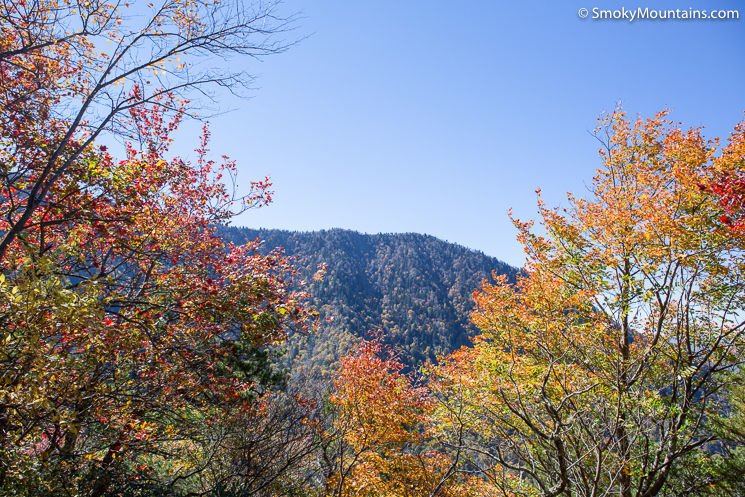Although the Southern Appalachians aren’t quite so world-famous for fall colors as the mountains of New England, the region nonetheless has plenty to offer in the autumnal-spectacle department. Great Smoky Mountains National Park, in particular, is its own celebrated destination for “leaf-peeping,” as sightseeing centered on fall colors is widely known. Indeed, October tends to see a secondary peak of tourism for this very reason.
The Great Smokies encompass one of the most diverse temperate forests in the world, host to 100 or so species of native trees, and most of these—plus a host of native shrubs—are deciduous broadleafs. Come fall, as photosynthesis winds down for these trees and shrubs and they prepare to drop their leaves, the dominant green pigments of the growing season decline and hues expressed by other pigments such as carotenoids and anthocyanins create a vivid tapestry of yellows, oranges, reds, purples, and other colors.
Besides the sheer diversity of deciduous trees and shrubs in the Great Smokies, the fall color show gets a significant boost by the elevational spread of the mountains, which after all are some of the very highest east of the Mississippi. At upper elevations, fall colors from beeches, mountain maples, hobblebushes, and other species typically begin as early as mid-September, while the climactic color display in the lower cove forests put on by such showstoppers as sugar and red maples, sweetgums, scarlet oaks, and tulip-poplars often peaks sometime between late October and early November. This means you’ve got quite a lengthy window for enjoying the multi-toned scenery as it gradually works its way from mountaintop and ridge crest down to the valley lowlands.
You can learn more about fall colors in the park—right here. Meanwhile, here are five of the very best trails in the park for surveying the mountains’ tremendous fall kaleidoscope!
1. Clingmans Dome Trail

Given just how much mountainscape is visible from the highest peak in the Great Smokies, it shouldn’t come as a surprise that the trail up to 6,643-foot Clingmans Dome is easily one of the best leaf-peeping destinations in the national park. You’ll have much to gaze over just from the parking lot, but taking the short but steep half-mile paved path to the observation tower at the summit gives you an even more magnificent panorama. Clingmans Dome is especially good earlier in the season when mid- and higher-elevation forests are blazing, but on clear days it also gives you a topdown look at the lower-elevation colors later on.
2. Rainbow Falls Trail to Mount LeConte

This somewhat demanding 13.8-mile route up to the third-highest summit in the Great Smoky Mountains via Rainbow Falls is another great choice for leaf-peeping. Mount LeConte’s flanks provide far-reaching views of fall-patterned slopes, and the rich forests lower down along the way to Rainbow Falls put on their own up-close show.
3. Charlies Bunion Hiking Trail

This well-used trail heading at Newfound Gap reaches a famous overlook from the namesake Anakeesta Formation outcrop, and here again, the huge viewshed makes for a perfect leaf-peeper’s vantage. Just remember to watch your step and exercise caution at the Charlies Bunion crags!
4. The Jump Off

One of the most all-around scenic walks in Great Smoky Mountains National Park, the hike along the Appalachian and Boulevard trails to the cliff ledge on Mount Kephart called the Jump Off puts plenty of fall color in your sightlines. This is a ridge-hugging route with loads of vistas even before the Jump Off vantage itself, which offers an awesome look at Mount Guyot (the second-highest peak in the Great Smokies) and Charles Bunion. (You can easily combine a visit to Charles Bunion, incidentally, with the Jump Off hike, just to maximize your birds-eye-view leaf-peeping.)
5. Laurel Falls

One of the most popular hiking destinations in the park, the 80-foot, two-tiered plunge of Laurel Falls is stunning any time of year. When you can up the scenic ante with a walk through fall-fired woods to get there, though, it’s just extraordinary.



